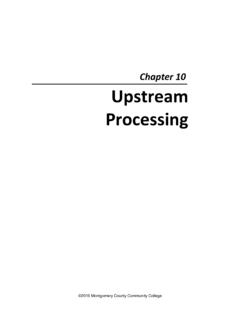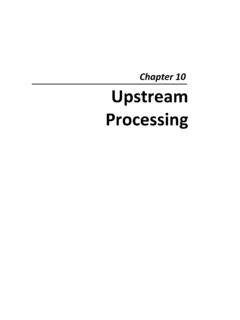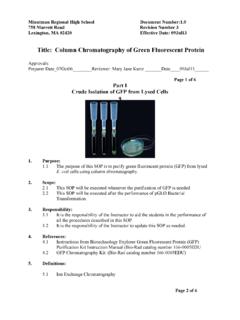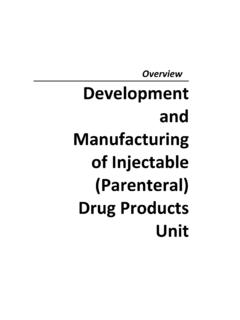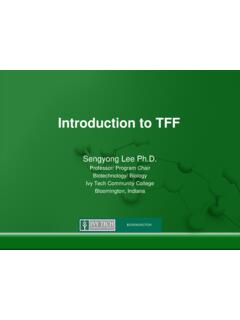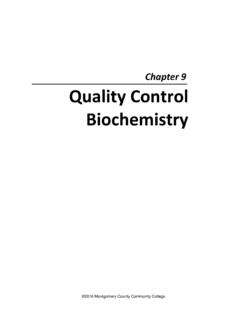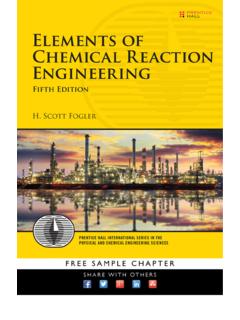Transcription of Chapter 11 Downstream Processing - Biomanufacturing
1 2016 Montgomery County Community College Chapter 11 Downstream Processing 424 Chapter 11 - Downstream Processing Objectives This Chapter provides an overview of Downstream Processing . After completing this Chapter , students will be able to: Describe the general elements of the Downstream purification process for a typical monoclonal antibody-based therapeutic, starting with the bioreactor harvest pool and finishing with pre-formulation, pure drug product. Explain the overall goals of the purification process from the standpoint of purity, yield, and efficiency as well as the general strategies employed to achieve these goals. Define the specific methods and in-process tools and materials used in typical steps of the Downstream process and the purposes and physical/chemical mechanisms occurring at each step, including: clarification of the bioreactor harvest by depth filtration and/or centrifugation capture chromatography for product concentration and initial purification ultrafiltration and diafiltration of the product at various stages in the Downstream process intermediate purification chromatography steps final polishing chromatography steps Describe general economic factors contributing to the cost of goods produced and common considerations/strategies for optimizing and improving those process economics.
2 Classify specific departmental contributions to the ongoing operation and maintenance of the Downstream unit operations within a facility. Introduction to Biomanufacturing 425 Terms Capture/recovery: the rapid separation of the product of interest from the growth media components and cell debris of the bioreactor Direct Flow Filtration (DFF): devices which allow the process fluid to cross the membrane in essentially a perpendicular flow direction. This provides little or no prevention of particulate build-up or the concentration of other elements that do not fit through the pore structure Intermediate purification: the removal of bulk contaminants, including host cell proteins and adventitious viruses as well as any potential contaminating leachates from other in-process materials Microfiltration: filtration that can be used at the start of the Downstream process to clarify the feed beyond what was accomplished in the upstream harvest and centrifugation/clarification Polishing: the elimination of trace contaminants and impurities, including inactive or unwanted isoforms of the desired therapeutic, or common impurities, including fragments or other chemical modifications thereof Sterilizing grade filtration.
3 Direct flow filtration (often involving the use of nanofiltration cartridges) that eliminates microbial organisms and insoluble proteins, removes adventitious and endogenous viruses, and sterile filters the product in preparation for final formulation Tangential Flow Filtration (TFF): devices that orient the membrane so that process flow sweeps across the active filtration surface, which minimizes pore plugging and surface fouling by concentrated retained elements of the feed Ultrafiltration: filtration used between chromatography steps to concentrate the product and change the buffer conditions in order to prepare it for subsequent chromatography steps 426 Chapter 11 - Downstream Processing Introduction to Downstream Processing Downstream Processing is the phase of Biomanufacturing typically considered to begin with harvest of bioreactor cell culture medium containing expressed active pharmaceutical ingredient (API) and finishing with a highly purified and appropriately concentrated product ready for final formulation and packaging.
4 This Chapter uses the monoclonal antibody-based (mAb) drug category as the representative example target drug to consider, as this category currently comprises one of the most common biotherapeutic classes produced today. The annual production demands for mAb therapeutics are high, due to both their relatively lower potency when compared to other biopharmaceuticals and the related need for larger and more sustained dosing. The market requirement for a typical approved mAb is 10 100 kilograms/year, employing bioreactor batch sizes up to 20,000 liters. Chromatography unit operations can range to two meters in diameter and packed resin bed volumes up to approximately 600 liters. Various economic analyses estimate that process development and clinical manufacturing costs can constitute 40 60 percent of a drug s development cost. Along with commercial manufacturing, driven largely by Downstream Processing consumable material costs, this can reach up to 25 percent of the sales revenue for the drug.
5 The majority of biotherapeutic mAbs and their derivatives are all produced by a similar set of methods. They are recombinant proteins and are most often produced in batch-fed mammalian cell expression systems. They are then harvested and purified by a series of orthogonal chromatography steps with intermediate filtration and virus inactivation/clearance steps. Orthogonal chromatography involves using related complimentary chromatography processes that are complimentary and compatible forms of purification. Mammalian cell lines are capable of mAb expression levels (titers) ranging widely from 5 g/liter harvest, with the appropriate degree of glycosylation. Glycosylation is the number and pattern of linked sugars at specific points in the drug polypeptide chains that enhance biological activity in the drug s therapeutic application. Mammalian cell expression systems result in relatively challenging feed streams.
6 This is due in part to host cell-derived contaminants that are liberated by cell attrition, along with other expressed host cell proteins and media additives (serum supplements or protein or other additives such as growth promoters or stabilizers). Given the drugs origins in mammalian systems, significant effort is required to ensure that no mammalian-infecting viruses reach the final drug. The final drugs must be free of adventitious agents such as bacterial pathogens or breakdown products ( endotoxins or cell wall components of Gram-negative bacteria). Drug production of a required purity and efficacy at reasonable cost per unit is the overall goal of the Downstream purification process. There are, however, several additional factors to be considered in approaching this goal. For example, the operational goals evolve over the development lifecycle of the drug, from the development or pilot laboratory to ultimate commercial manufacture.
7 In the early life of a drug candidate, developers may produce several variants of the primary molecule, which are rapidly screened for biological activity and stability. In parallel, an emphasis during this period is placed on the thorough characterization and Introduction to Biomanufacturing 427 stability of the compound, with less emphasis on the methods for its purification. Once the definitive target compound and detailed structure are established, the focus is immediately shifted to regulatory viability, from safety (Clinical Phase I) to efficacy in test animal subjects (primarily in Phases I and II) to human testing of both (Phase III). During these early, smaller scale stages of a drug s production, there is often little motivation to refine the Downstream Processing scheme. A potential failure in clinical trials would eliminate the need to carry the candidate forward in the development cycle.
8 Often during this period there may also be commercial decisions related to the developing organization's economic condition, constraints, and commercial goals. It is quite common for the candidate drug to be developed initially in an academic entity or entrepreneurial biotechnology firm, which is solely interested in licensing it to a larger, established pharmaceutical firm. The larger firm, with its greater development resources, can then bring the drug candidate to maturity. The firm can make the candidate the subject of either 1) an Investigational New Drug (IND) filing for approval of sale in the United States or 2) another country s approval process/agency. Only then is focus given to the means by which the drug will be produced at larger scale. Once a drug shows promise in clinical trials, there is often a need for rapid progression to small scale production. This reduces time invested in process optimization to ensure robust and high-yielding processes.
9 Compressed marketing schedules can also limit operator/technician training opportunities; full validation of the impacts of critical operational variability; the thoroughness of raw material and equipment supply chain audits; the degree of automation planned for the Processing equipment, etc. Compromises in each of these areas results in higher risks when transferring the process to manufacturing, with real potential for extremely low yields and contaminated/discarded batches. Despite their intense attention to chromatography resins and other in-process, product-contacting materials (used to validate products as having low or no extractables or leachates), drug manufacturers must also prove that these contaminants are absent or below detectable levels ( they are removed via the Downstream process). The Downstream Processing purification efforts must also prove effective at removing impurities or components distinguished from contaminants by having direct relation to the product of interest.
10 These impurities could be incompletely expressed product, remnants of the proteolysis of target or other proteins, or aggregates of the target product. Drug safety assurance is governed by federal regulatory agencies with many specific requirements. For example, the position of the FDA on virus safety can best be seen in this guidance: All production processes should incorporate effective validated steps for the inactivation/removal of a wide range of viruses of diverse physicochemical is desirable to incorporate two distinct effective steps which complement each other in their mode of action. 428 Chapter 11 - Downstream Processing Therefore, assurance of the absence of viruses typically dictates clearance using a combination of orthogonal methods within the Downstream processes. These viruses can originate from the expression cell line, by introduction from the environment, or from growth medium, reagents, or other in-process materials.
